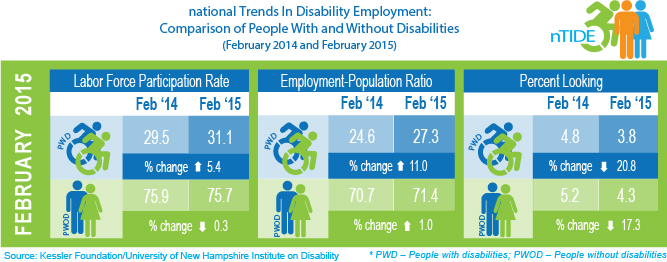DURHAM, NH – April 3, 2015. For the sixth consecutive month, Americans with disabilities continue to find employment, according to today's National Trends in Disability Employment – Monthly Update (nTIDE), issued by Kessler Foundation and University of New Hampshire’s Institute on Disability (UNH-IOD). Job training is one strategy that is helping individuals with disabilities start careers.
In the Bureau of Labor Statistics’ Jobs Report released Friday, April 3, the employment-to-population ratio for working-age people with disabilities increased from 24.6 percent in March 2014 to 27.2 percent in March 2015 (up 10.6 percent; 2.6 percentage points). For working-age people without disabilities, the employment-to-population ratio increased slightly from 70.7 percent in March 2014 to 71.7 percent in March 2015 (up 1.4 percent; 1 percentage point). The employment-to-population ratio, a key indicator, reflects the percentage of people who are working relative to the total population (the number of people working divided by the number of people in the total population multiplied by 100). In comparison to March 2014, 555,000 more Americans with disabilities are in the workforce.

“Over the past six months, we have seen more Americans with disabilities becoming employed relative to the same months in the previous year,” according to John O’Neill, Ph.D., director of employment and disability research at Kessler Foundation. “What’s most notable is that the gains for people with disabilities are outstripping the gains made by people without disabilities. This good news is still tempered by the fact that there remains an employment gap of 44.5 percent between people with and without disabilities.” (The employment gap is the difference in the employment-to-population ratios between people with and without disabilities.)
For people with disabilities, the labor force participation rate also increased from 29.5 percent in March 2014 to 31.1 percent in March 2015 (up 5.4 percent; 1.6 percentage points). For people without disabilities, the labor force participation rate decreased slightly from 75.9 percent in March 2014 to 75.8 percent in March 2015 (down 0.1 percent; 0.1 percentage points). The labor force participation rate is the percentage of the population that is working or actively looking for work.
“The last few months have been very encouraging—workers with disabilities are outpacing workers without disabilities for the first time in a very long time,” said Andrew J. Houtenville, Ph.D., associate professor of economics and research director at UNH-IOD. “This could mean that the economic recovery from the Great Recession is finally reaching people with disabilities.”
Americans with disabilities are honing their job skills and finding lasting careers. Kevin Greene, 30, from Kearny, N.J., sustained injuries to the brain and spinal cord in a car accident. In a wheelchair and looking for a new career path, his interest in science led him to the laboratory assistant training program at JFK Vocational Rehabilitation Department—an initiative funded by Kessler Foundation. Upon completion, Greene quickly landed a job maintaining a small laboratory. Today, Greene is a customer service representative at LabCorp, earning a competitive salary and full benefits.
"My job training prepared me for a career that I love,” said Greene. “As people with disabilities continue to enter the job market, it will encourage more improvements in society. Accessibility is increasing in workplaces and employers are realizing that a person with a disability can do a job just as well, if not better, than an able-bodied employee.”
In March 2015, among workers ages 16-64, the 4,359,000 workers with disabilities represented 3.1 percent of the total 139,158,000 workers in the U.S.
“The statistics in nTIDE are not seasonally adjusted,” noted Dr. O’Neill. “Because disability employment data have been collected for so few years, more time is needed for seasonal trends to become evident.”
The next nTIDE will be issued on Friday, May 8, 2015.
NOTE: The statistics in the National Trends in Disability Employment – Update are based on Bureau of Labor Statistics numbers, but are NOT identical. They have been customized by the University of New Hampshire to efficiently combine the statistics for men and women of working age (16 to 64).
nTIDE is funded, in part, by grants from the National Institute on Disability, Independent Living and Rehabilitation Research (NIDILRR) (H133B130015 & H133B120005) and Kessler Foundation.
The Institute on Disability (IOD) at the University of New Hampshire was established in 1987 to provide a university-based focus for the improvement of knowledge, policies, and practices related to the lives of persons with disabilities and their families. Its mission is to promote full access, equal opportunities, and participation for all persons by strengthening communities and advancing policy and systems change, promising practices, education, and research.
The University of New Hampshire, founded in 1866, is a world-class public research university with the feel of a New England liberal arts college. A land, sea, and space-grant university, UNH is the state's flagship public institution, enrolling 12,200 undergraduate and 2,300 graduate students.
